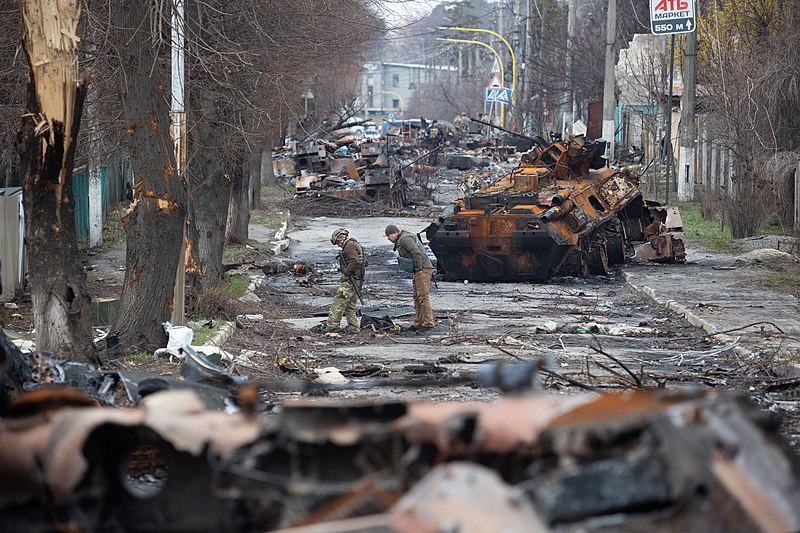 Main Street of Bucha after Russian Attack | Credit: Ukrainian Government
Main Street of Bucha after Russian Attack | Credit: Ukrainian Government
How OSINT Has Shaped the War in Ukraine
Russia’s invasion of Ukraine has proven to be more difficult for the Russian military than either Russia or the world generally predicted. As the invasion enters its fourth month, much of Ukraine’s success in its fight against the Russian military can be attributed to the role open-source intelligence has played in the war. Open-source intelligence, or OSINT, has given Ukraine an edge both militarily and politically. This edge has allowed Ukraine to withstand Russia’s assault.
Open-source intelligence is information gathered through public sources and then processed, synthesized, and analyzed into intelligence. These public sources can range from commercial satellite images to unencrypted radio messages and public social media posts. In recent decades, the role of OSINT in the intelligence community has increased exponentially due to the increased role the internet plays in our society. According to the Defense Intelligence Agency, about 80% of DIA intelligence today comes from open–source material. The ability of the Ukrainian government, military, and people to tap into this wealth of information has helped shaped the war in Ukraine’s favor.
Militarily, OSINT has allowed the Ukrainian military to track Russian military movements, plans, and operations. Satellite images have given Ukrainians information on areas Russian troops have attacked. Unencrypted radio waves and cell phones have allowed Ukrainians to eavesdrop on Russian communications. Social media posts, from both Russian soldiers and Ukrainian citizens, have shown what the war looks like on the ground, giving Ukrainian officials information on where and how the Russian military is operating. These advantages provided by OSINT have allowed Ukraine to challenge strongly Russia’s stronger, larger, and more technically advanced military.
Politically, OSINT has swung the international opinion in favor of Ukraine by exposing the horrors of the war and disproving the disinformation spread by the Russian government. Before the war started, the U.S. and Ukraine predicted that Russia was going to use a false flag operation to justify their attack. However, the mass of open-source intelligence has allowed Ukraine to prove that these “justifications” and false-flag operations are merely Russian propaganda. Consequently, more countries have been quick to show their support for Ukraine as the Ukrainian government has been able to prove that the invasion was unjust. Moreover, OSINT has revealed that the Russian military has been attacking and targeting civilians, further increasing the amount of international support for Ukraine. The primary example of OSINT disproving Russian claims comes from the town of Bucha, where Russian officials claim that the execution scene discovered by Ukrainian forces was staged using Russian casualties. However, satellite images showed that the bodies had been lying on the ground for weeks before Ukrainian forces arrived. Finally, facial recognition software, like the Russian findclone.ru has been used to match faces of Russian soldiers pictured in social media posts to names, further opening the door for OSINT to be used as evidence in future war crime trials.
In addition to increasing international support for Ukraine, OSINT has also increased support for the fight against Russia among Ukrainian citizens. OSINT has revealed failures of the Russian military and successes of the Ukrainians, giving Ukrainians more hope that they can fight the Russian military off. Morale and the Ukrainian national identity have been strengthened as a result, thus making the fight against the Russians that much stronger.
The impact of open-source information has not gone unnoticed by Russian officials. In response, the Russian government has been focused on pulling Ukraine under its umbrella of censorship. In some cases, the infrastructure is being destroyed or disabled; estimates say that around 20% of telecommunications infrastructure in Ukraine has been damaged by the Russians. In other cases, Russia is rerouting Ukrainian telecommunications infrastructure to go through Russian internet providers. This allows the Russian government to monitor emails, text messages, and other communications sent through Russian internet, curbing the spread of open-source information.
It is clear that the unique widespread availability and amount of OSINT has shaped the Ukrainian war to a degree that has never been seen before, and it will continue to do so even after the war has ended. It is also clear that the prevalence of OSINT in warfare will not stay unique to Ukraine as the importance of OSINT in warfare will continue to increase due to the increasing prevalence of the internet and social media in people’s daily lives.






